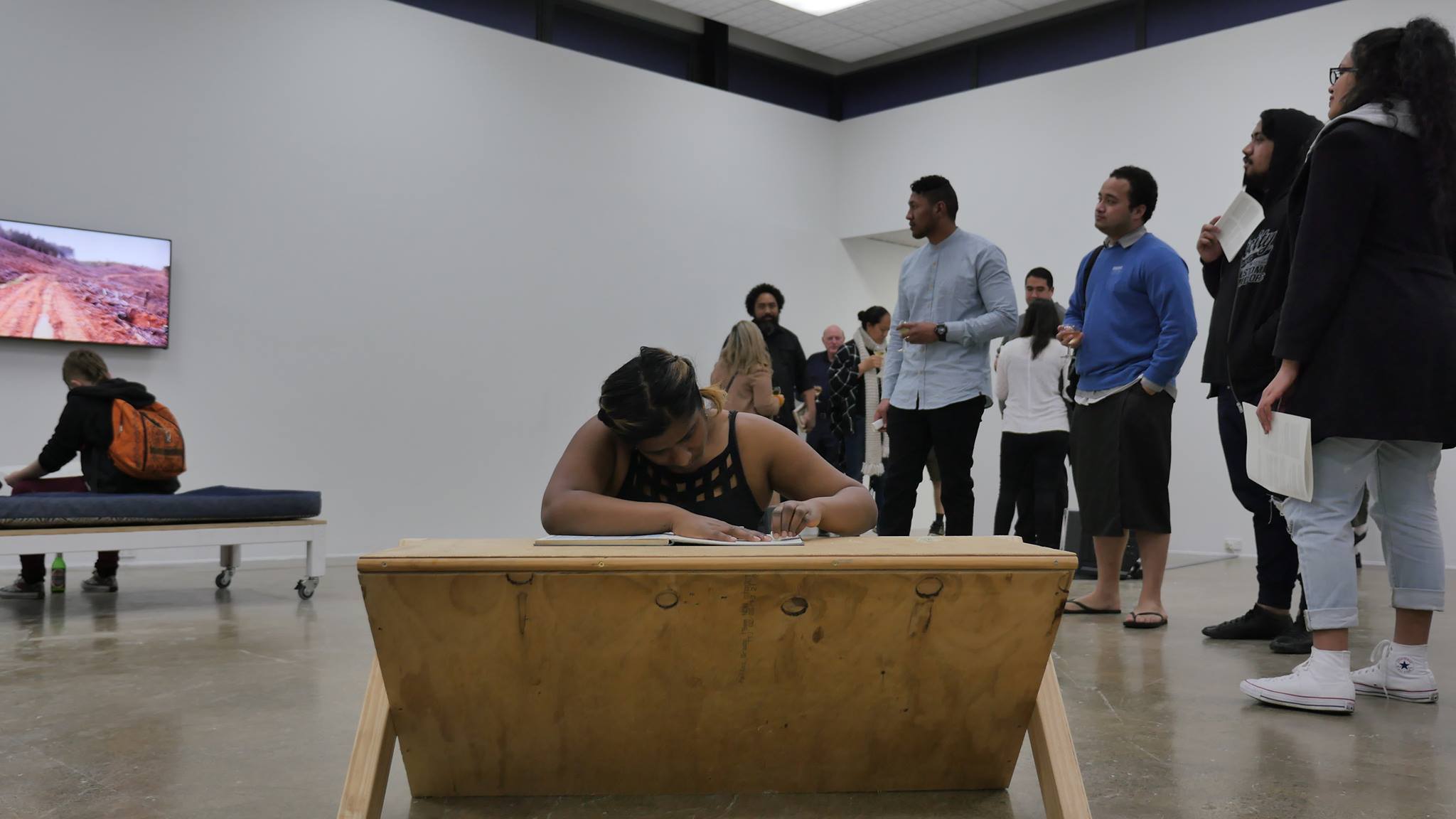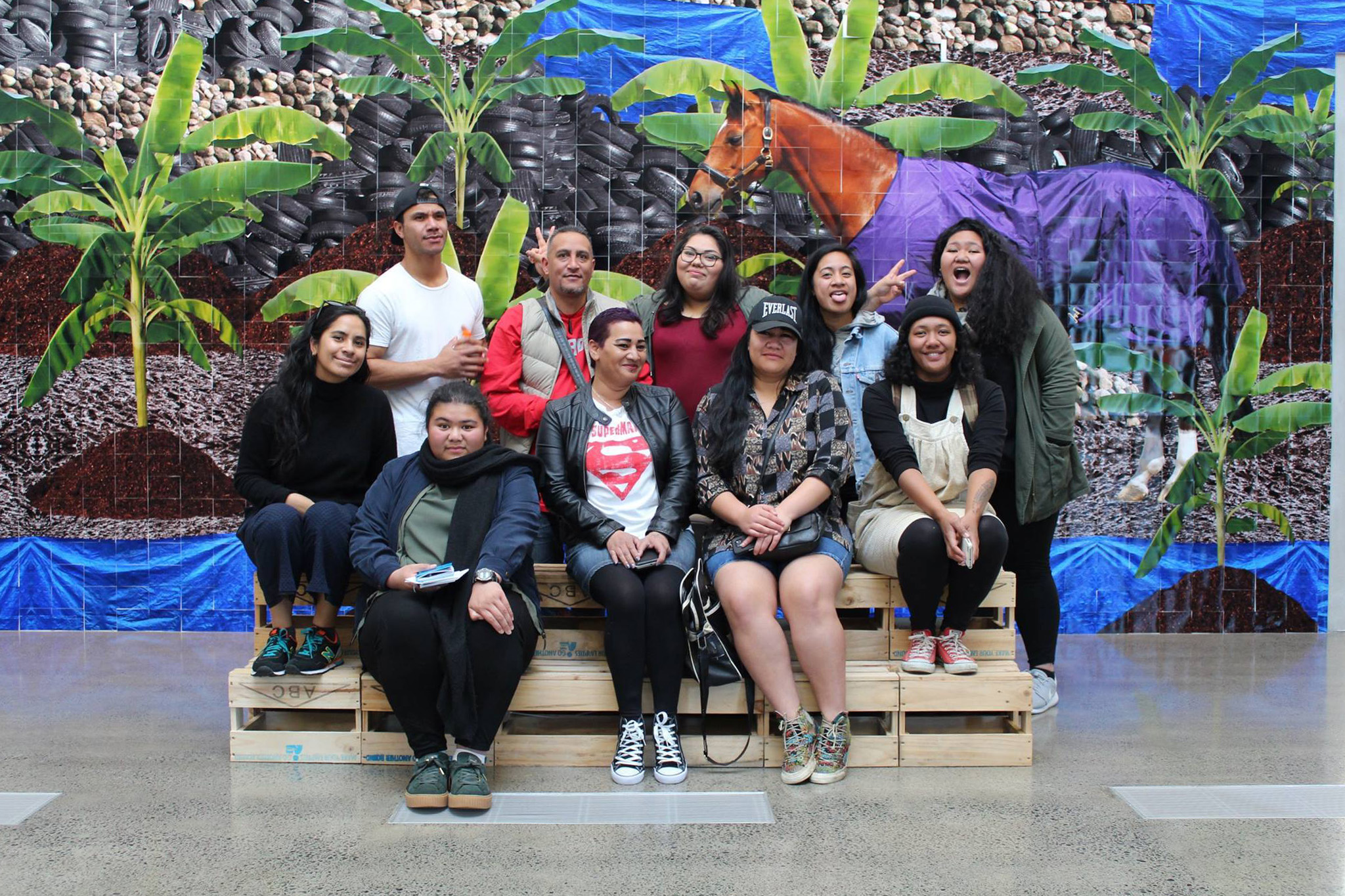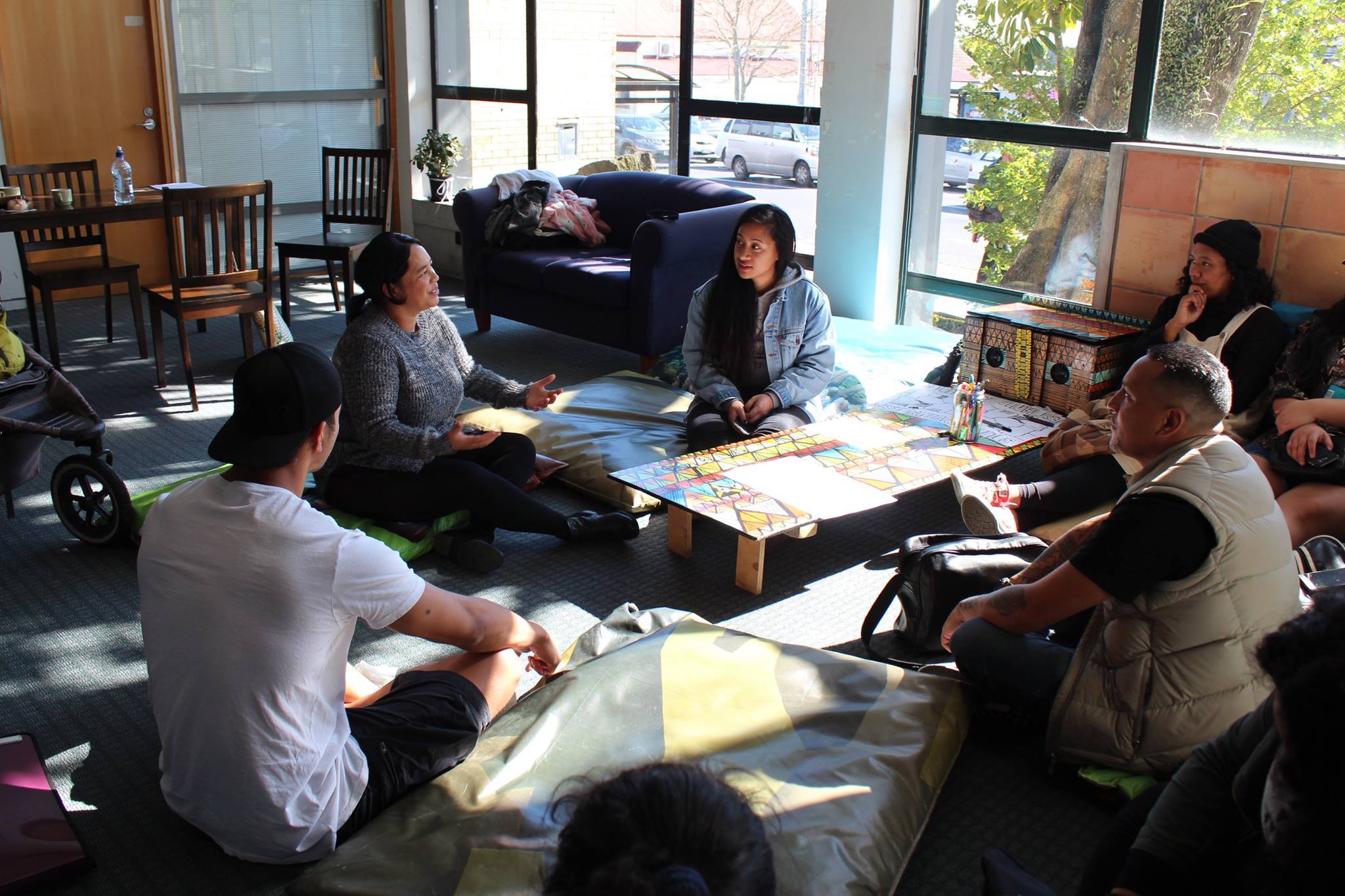Ioana Gordon-Smith (IGS): The editors of this publication have asked us to discuss your time at Papakura Art Gallery and Artspace, Auckland. I suspect the idea was prompted by your text, ‘Diary of a gallery girl’, commissioned for Localise, a temporary newspaper project that Lana Lopesi and I produced for the 2015 Whau Arts Festival.1 The aim of the newspaper was to interrogate how we envisage or evaluate what makes ‘good’ community art in light of the trendiness of the catchphrase at the moment. So perhaps let’s start there? I actually feel like this is a nice format, to be in conversation with you, cause I know we worked quite closely on that text. But for readers who haven’t come across it, what was it that you wanted to talk about in your essay ‘Diary of a gallery girl’?
Louisa Afoa (LA): The opportunity to write for Localise came right after I had finished the education internship at Artspace and as you mentioned I worked at Papakura Art Gallery a year before as a gallery assistant, a position that was heavily involved in public programming and running workshops with children. Through ‘Diary of a gallery girl’, I was hoping to perhaps critique these positions that expect you to be able to dial a community for projects at the institution’s whim, and the measuring involved of participants in the gallery. At times I really felt that as a brown female it should be easy for me to bring in ‘the brown community’; however, building relationships takes time. Attempting to create accessibility is not a bad thing, but as a Pacific person who engages in the world a certain way there were definitely times that I felt a disconnect between myself and the institution. For example Artspace as an institution has a legacy of providing an array of exciting contemporary dialogues and I found that really intimidating and was constantly scared that I would ‘fail’.
Did you have a similar experience?
IGS: I was at Artspace back in 2013 as the very first intern under the Tautai/Artspace partnership, so ‘education’ was kind of this vague cloud that hung around in the office that no one really knew how to approach. There wasn’t an existing education department, strategic vision or staff member. I wasn’t really making mistakes because I didn’t know where to start. I spent a lot of time reading and talking to other educators to try and work out the purpose or what is most important, what the goals are in an education programme. I feel like when I was there, there was not much thought about the internship at all, so I feel like I didn’t formulate my own agenda either cause I had no clue at all what my parameters were. Being a nine-month internship also, it was difficult to plan ahead or align with local schools, which (as I learned) work with quite long lead-in times. Ahilapalapa Rands, who received the internship after me, was a lot better at being gung-ho and exploiting not having guidelines.
One of the things I love about Artspace is its rigour; its non-compromising attitude to allowing artists to take risks, be process-driven and really thorough with research. And I think Artspace’s primary community (arts-literate, tertiary-educated) appreciate this level of criticality. I do too. I don’t think that is how all art spaces should be, but I appreciate that there’s somewhere where a programme isn’t compromised by thinking about audience numbers.
A lot of the things I was reading (Nina Simon was a constant go-to)2 felt somewhat separate to or incompatible with how Artspace operates with its commitment to an artist’s ideas. There were some projects I initiated, like one-on-one mentoring between teenagers and emerging artists, which resulted in an exhibition. But for a lot of the time, I guess I was in a state of paralysis, a constant suspension between how much an artist’s work should be relatable and how much onus was put on the audience to think through things on their own. I think there’s actually a tension between accessibility on one hand, and protecting an artist’s right not to be accessible on another. So what is it that we’re actually striving for? I wonder if it isn’t accessibility, as in how digestible an exhibition might be, but just simply access, that is, the ability to encounter an exhibition in the first place.
I think you’ve made a similar observation with ‘Diary of a gallery girl’. This idea of access, engagement, participation, whatever, all being entirely dependent on getting people in first. You wrote:
What is engagement? French philosopher Jacques Rancière would say that there is no such thing as a passive viewer: as soon as a person sees an artwork, he or she is already trying to understand it through his or her past experiences. Audiences can’t be passive, because in the moment of encounter, they’re already engaging. I get that, and it makes sense, but if there’s no one coming into the gallery, then Rancière’s theory becomes irrelevant.3
LA: I think that’s a really great way to think about it: access versus accessibility. And with the ability to encounter comes the position of encountering. And so, class plays a big role when we think about ‘access’. Thinking back to my internship, creating access was really important for me. Although, I wasn't thinking about the term conceptually, just intuitively.
The weekly photography workshops that took place at Tangaroa College are one example. I would take a couple of students out during their art period to take photographs that were then used for research for their painting boards and a pop up show at Fresh Gallery. The school didn’t have the resources to bring students all the way to the city and so it just made sense to go to them.
This is a random story but, you know, I’m all about anecdotes: Edith Amituanai was telling me she took a group of students to see Space to Dream: Recent Art from South America (2016) at Auckland Art Gallery (AAG)—a group of brown kids, basically. The attendant had asked them if they had paid. It’s funny how the AAG has a massive outreach programme led by some really great people, and how that hard work comes undone by an assumption made by a gallery assistant who probably, to this day, doesn’t realise how s/he made those kids feel.
IGS: That experience happened to a friend of mine at Space to Dream too. And he was convinced two palagi people in front of us didn’t get asked. I’m not sure if there was anything in that, but Space to Dream, for him, wasn’t an isolated experience of, at worst, feeling monitored in a gallery space and, at best, feeling acutely uncomfortable. Do you think galleries should be working harder to make people feel more welcome?
LA: I feel like public spaces like the AAG that receive substantial amounts of funding have a different level of responsibility to the public in comparison to say a dealer gallery. If a gallery staff member is racially profiling who they think paid for tickets versus who didn’t, then it’s a huge problem. How can the gallery ever expect to create shifts in these negative perceptions people have of galleries if assumption is so engrained in its mode of operating. It’s such a disservice to the public that it’s supposedly for. I think that because my own experiences and experiences like Edith’s and your friend’s, I often think about the encounter between audiences and the gallery and the factors that contribute to the experience.
IGS: Can you think of any experiences where you’ve felt that spaces were made more or less welcome?

Shivanjani Lal, ‘में यहाँ नहीं हुँ – I am not here’, Offstage 7, curated by Louisa Afoa, Artspace Auckland, 3–15 September 2015. Courtesy of Tautai Contemporary Pacific Arts Trust.
LA:The opening of Offstage 7 (2016)4 at Artspace was lit! I know I’m in a biased position because I was the curator, but there is a shift that takes place when minorities become the majority in a big institution like Artspace. I often find myself going to openings and being really aware that I’m one of the few POC’s in the crowd and so the shift in perception is really bodily. Perhaps this is because there is no question that the show is for us—Tautai Contemporary Art Trust’s annual moving image and performance event began due to a lack of space for new and experimental work by Pacific artists and is now in its seventh year. One of the younger artists in the exhibition saw me the next day and told me how happy her parents were. It was their first time attending an exhibition she was in and it meant a lot to them to see that their daughter was supported in the art community by so many Pacific people. For me there’s so much value in that—although it might not be the access that we imagine when we think about community engagement, its still an important encounter as it contributes to the infrastructure of support for a young artist. Family is important.
Earlier this year, one of the trips I helped organise as the Tautai Tertiary Liaison, was a trip to Te Uru in Titirangi and All Goods artist-run space in Avondale for MIT visual art students. I wanted to take the students to see Janet Lilo’s exhibition Status Update (2016). Te Uru is a bit of a mission when you live out South and I knew it was one they shouldn’t miss. They totally loved the exhibition, of course, but a moment I appreciated just as much is when they saw Jae Kang’s exhibition Gurmon Sup upstairs. I had forgotten that Jae went to MIT for her undergraduate studies and most of the students remembered her. I overheard them saying how ‘mean’ the work was and how it had developed in comparison to the previous work that she had installed at MIT for her grad show. Although Jae’s not a Pacific artist, she was part of their MIT community. They might not have known her very well but they were still just so stoked to see an alumna in Te Uru. The art world can be pretty cut-throat at times and so to witness the support the students had for Jae was pretty uplifting. Funnily enough I was in the students’ position just the week before when I had attended Janet’s opening, I was so happy for Janet that I almost cried.

Students from Manukau Institute of Technology visiting Janet Lilo, Status Update, curated by Ioana Gordon-Smith, Te Uru Waitakere Contemporary Gallery, Auckland, 28 May – 28 August 2016.
Afterwards, we took the students to All Goods,5 which is such a comfortable space with beanbags and tables available to bring food and have lunch—which we totally did. Janet met the students there. When we had to leave, a group of students gave her a bunch of bananas. It was so great! How many artists out there can emit such a welcoming presence that a student would buy you a bunch of bananas and know that it would be cool?
These moments that I’ve shared are interesting to me because they’re pretty humble gestures—but through them, they reveal how small shifts can contribute to changing the dynamic between audience, artwork and artist, which is inconsistent with ‘the mainstream’. I don’t think its about being one or the other, but having a fluidity with ways that we can engage and not having a valuing system that creates a hierarchy between them.
I think they could look really different to you as the curator of Te Uru. I can imagine the types of outcomes expected would be super diverse. Do you have some recent examples? You have also curated versions of Offstage, one was at Artspace and one was a part of the first Whau Arts Festival—they must have had such different vibes!

Students from Manukau Institute of Technology visiting artist Janet Lilo at All Goods, Auckland, during Andy Leleisi’uao’s solo exhibition The Blue People, 13 August – 4 September, 2016.
IGS: Curating Offstage 5 (2013) at Artspace was a highlight for me. Like you, I remember the vibe of the opening (and only) night being completely different to any other opening; it felt less performative, way more about family and friends rather than colleagues. The spirit was celebratory, rather than network-y.
I get that programming is one way to change who does and doesn’t feel included or reflected in a gallery space, but I’m also interested in whether or not the accessibility of any given exhibition can be about something other than programming. Is there room to feel welcome in a space that doesn’t represent anything that you feel connected to, or indeed even challenges your worldview?
I think we undervalue ‘customer service’ in galleries, as if art is autonomous and that its potential as an encounter exists in a vacuum, independent of the social context of a gallery. With this iteration of Offstage, for example, the one thing that stands out for me is that one of the artist’s mums came in early. Rather than asking her to come back, or letting her mill around on her own, I took her around the works. I didn’t really explain them, but just sat with her in front of some of the videos. When we got to Linda T’s work, which was an installation featuring video documentation of a recent trip to Samoa, we just talked and laughed about how familiar it was to see footage shot from the back of a truck. But in some ways, I think the ‘encounter’, for this visitor, was equal part with the work and equal part with me. So, how much is accessibility related to programming and how much is it simply about a gallery’s level of hospitality?
LA: I wonder, similar to our previous conversation about works being made ‘accessible’, does the exhibition space need to feel welcoming? Is this possible when the energy of a space constantly shifts with each exhibition as it brings in different ideas and agendas? I remember experiencing Ignas Krunglevicius’s work Interrogation at Te Tuhi in 2015. It’s an intense viewing experience that is intentionally destabilising rather than welcoming. And so, like you mentioned, that initial greeting to the space becomes really important.
I agree that we undervalue the front-of-house staff in the gallery, because before entering the exhibition space to see Interrogation I was greeted with a smile from the receptionist, which I always appreciate. Personally, I’m very conscious of how people treat me in spaces and whether I get a smile, the side eye and a “can I help you?” that feels genuine versus a “can I help you?” that makes me feel like I don’t belong.
I’ve been thinking recently that perhaps we expect too much from the audience. Do we fall into the trap of having a preconceived romantic notion of how we want the audience to experience the artwork? At the Contemporary Pacific Arts Symposium in Melbourne last year I remember a speaker saying that you can’t go into a community and have the mentality that you’re ‘saving them’, because who are you to say they need saving?
IGS: Yeah, I agree that preconceptions of audience responses are problematic. I think for me it’s less about saving communities and more about registering that galleries are public spaces that often feel like they’re not spaces that all communities feel they have ownership of. I think there are lots of tricky things to navigate when seeking to change that, but one thing the Artspace internship did teach me is that at a certain point, the best research is just to try out different approaches and see how they land.
LA: Totally, there’s no one size fits all.